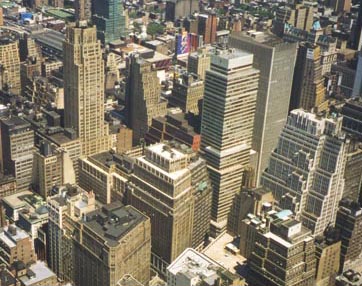Urban Areas
Increased Runoff: The porous and varied terrain of natural landscapes
like forests, wetlands, and grasslands trap rainwater and snowmelt and
allow it to slowly filter into the ground. Runoff tends to reach receiving
waters gradually. In contrast, nonporous urban landscapes like roads, bridges,
parking lots, and buildings don't let runoff slowly percolate into the
ground. Water remains above the surface, accumulates, and runs off in large
amounts.
Storm Sewer Systems: Cities install storm sewer systems that quickly channel this runoff
from roads and other impervious surfaces. Runoff gathers speed once
it enters the storm sewer system. When it leaves the system and empties
into a stream, large volumes of quickly flowing runoff erode stream banks,
damage streamside vegetation, and widen stream channels. In turn, this
will result in lower water depths during non-storm periods, higher than
normal water levels during wet weather periods, increased sediment loads,
and higher water temperatures. Native fish and other aquatic life cannot
survive in urban streams severely impacted by urban runoff.
Increased Pollutant Loads: Urbanization also increases the variety
and amount of pollutants transported to receiving waters. Sediment
from development and new construction; oil, grease, and toxic chemicals
from automobiles; nutrients and pesticides from turf management and gardening;
viruses and bacteria from failing septic systems; road salts; and heavy
metals are examples of pollutants generated in urban areas. Sediments and
solids constitute the largest volume of pollutant loads to receiving waters
in urban areas.
Pollutant Damage: When runoff enters storm drains, it carries many of these pollutants
with it. In older cities, this polluted runoff is often released directly
into the water without any treatment. Increased pollutant loads can harm
fish and wildlife populations, kill native vegetation, foul drinking water
supplies, and make recreational areas unsafe.

An urban area
From
EPA
Pointer
No. 7
EPA841-F-96-004G



